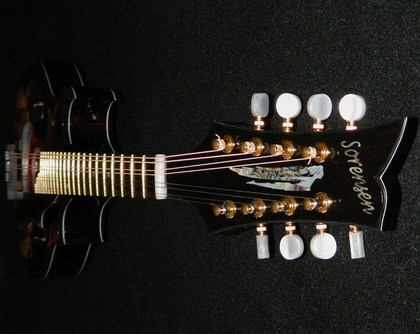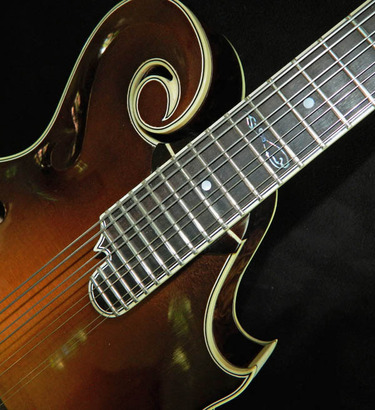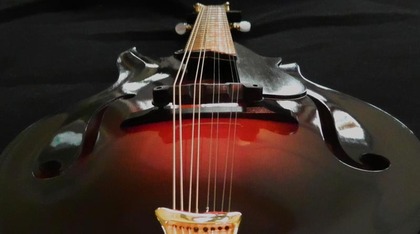« Pentatonic Scales; a whole new level! |
Main
| John McGann; Right hand considerations for flatpicking »
 July 25, 2013 | The Quest for "Playability" July 25, 2013 | The Quest for "Playability"
We consider the Golden Bear state's Steve Sorensen one of the most talented new builders on the scene. After reviewing one of his asymmetrical 2-point "Sprite" mandolins a couple years ago, we couldn't resist commissioning the build of a personal signature version, our own blueburst Sprite JM. It's a terrific instrument, and Sorensen's career trajectory is one to keep track of; we anticipate a significant impact on the global stage of premium builders.
We have the privilege of bringing you some of the thoughts and philosophies on maximizing a mandolin's tone from his bench in this week's Tips and Tricks column.
Enjoy!

The Quest for "Playability"
Steve Sorensen
As a builder, I'll admit, it is fun to make instruments that are visually attractive . . . I guess you could call that "eye candy". But the ultimate goal is to create that elusive mix of traits which make a mandolin, "Easy to play and hard to put away."
The importance of "Playability" and understanding what makes an instrument feel comfortable and attractive for hours and hours of play time comes from a blend of essential common features and a few individual preferences that are both simple to list and hard to achieve.
At the most simple level, ease of play is directly tied to how much or little work your left and right hands need to do to generate the musical tones you hope to move from inside your head out into the world. Every mandolin player has heard about the finger-busting string height played by bluegrass legend Bill Monroe. Top bluegrass players tend to pick with great vigor, so having strings off the neck help avoids "rattin' out" -- those buzzy-fuzzy tones that happen when strings are not able to cleanly vibrate after they are picked. But the need for extremely high action to cover up flaws in the mandolin's structure and set-up should not be tolerated.

Keys to getting clean playing and easy noting at a relatively low action include:
Fret Dressing and Leveling. Every note should play cleanly at every fret when picked lightly and remain clean when driven by an aggressive, hard pick-stroke even when string height at the 12th fret is set at or below 1/16th of an inch. In addition, fret ends should not ever be noticeable to the sides of your fingers.
The Neck. While I have often heard new mandolin players talk about the need for a bigger neck, I have seen that experienced players can quite easily grab a mandolin with a 1" nut and play with ease. The reality is that bigger does not make better.
There was great wisdom in the neck design of the pre-1920s Gibson mandolins which were narrow, slim and slightly "V" profiled. While you may find that your prefer a wider neck, you should grab every opportunity to play instruments from and modeled after those petit beauties from the period when the mandolin was the most popular instrument in the western world. You will likely find that once you are able to fret cleanly with a small neck, the desire for a bigger neck profile begins to fade . . .
The Nut and Bridge. Spaces between the courses of strings must be even and the spacing of pairs should be consistent. The most interesting missed trait of "easy to play" instruments is the individual string height coming off the nut: slight differences in the height of the two strings in a pair force your fingers to compensate by pressing harder or differently from note to note as you play. To check this, fret on the first fret and note how each string moves down as you press it with your finger . . . Both strings of each pair should clear the first fret with just a wee bit more space than you see under the second fret when you fret at the first fret and be exactly the same height above the frets.
String spacing must also be consistent at the bridge both between courses and for each pair. In addition, at first glance, it should be apparent that the bridge stands evenly and doesn't need to be "jacked-up" on one side or the other to achieve proper string height, and that with the feet of the bridge are evenly spaced from the centerline of the mandolin. In all cases, the feet of the bridge (or the full surface for full-contact bridges) should be flush with the top with no gaps or spaces between the base of the bridge and the top.
Tone, Response and Intonation. I'm sure you have noticed that skilled and experienced players will immediately make just about any instrument "sound like them". But the best instruments draw more music out of great players . . . That is, the quick, easy, consistent and melodious response of the instrument generates an increased focus and range from the player which does not happen (without forced effort) when the mandolin is tight, uneven in response across the neck, or inconsistent in the way it responds to the pick.
At the most basic level, once the bridge is properly placed, intonation should be correct at every fret of the fingerboard. Individual notes should not go sharp or flat because of the stretching that occurs as you fret or because of mechanical/structural problems with the instrument.
Of course, responsiveness and tone are where the real differences arise between "Acceptable", "Good", "Excellent," and "Extraordinary". The reason that there is such a huge range in pricing between entry-level and top mandolins is that it is quite easy to make an instrument that sounds like a mandolin . . . but extremely difficult to blend and adjust those features to create an instrument that is both consistent and wide-ranging in its response to the player.

Clearly, the aspects of "Playability" touched on here could (and have) resulted in volumes of text and hours of discussion. My goal, as a builder and player, is to get you thinking about the tangible physical and tactile aspects of the mandolin which come together to make for an instrument that you can't help but keep playing.
I have experienced the distress of having a top player pick a few notes, smile kindly and hand back an instrument with a gentle, "Yeah man . . . cool." and also felt the elation of watching music legends, reluctantly pick a few notes, start into a tune, stop to grab a chair, then stay and play and play and play. I've realized that the only thing better than watching player pick, stare in wonder, then continue playing is when I get that feeling myself -- when I realize the instrument is pulling more from me than I knew I had and makes me wish I could just keep picking forever. That's why it's called playing!
If you are a new player, be bold about asking for a chance to play many instruments. As your knowledge, experience and skill increase, so will your ability to discern what makes an instrument truly playable for you. With that growing knowledge and confidence will come the thrill of finding the mandolins that are, "easy to play and hard to put away."
Steve Sorensen, Luthier
Sorensen Mandolin & Guitar Co.
Visit website
steve@sorensenstrings.com

Posted by Ted at July 25, 2013 5:15 AM

Disclaimer: In the 'Information Age' of the 21st Century,
any fool with a computer, a modem, and an idea can
become a self-professed 'expert." This site does not
come equipped with 'discernment.'
|



